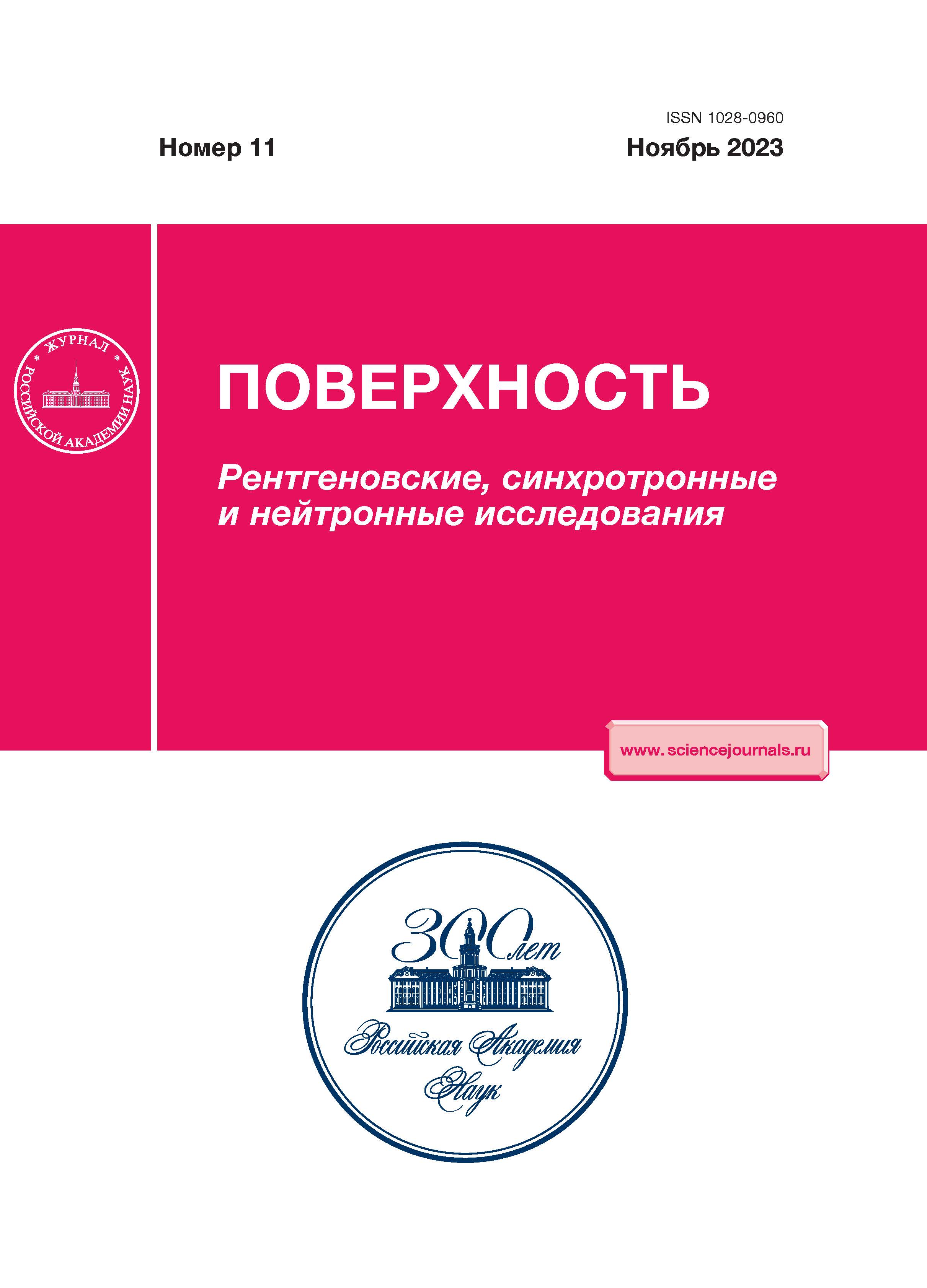The Size Dependence of the Adsorption Properties of Nickel Clusters on the Surface of Aluminum Oxide
- 作者: Magkoev Т.Т.1,2, Nadimi E.3, Tvauri I.V.1, Zaalishvili V.B.2, Ashkhotov O.G.4, Ashkhotova I.B.4
-
隶属关系:
- Khetagurov North Ossetian State University
- Geophysical Institute-The Affiliate of Vladikavkaz Scientific Centre of the RAS
- K.N. Toosi University of Technology
- Berbekov Kabardino-Balkarian State University
- 期: 编号 11 (2023)
- 页面: 67-71
- 栏目: Articles
- URL: https://archivog.com/1028-0960/article/view/664720
- DOI: https://doi.org/10.31857/S1028096023110122
- EDN: https://elibrary.ru/WEVRFQ
- ID: 664720
如何引用文章
详细
Despite the recent activity in the field of research on the properties of systems formed by the adsorption of metal atoms on the surface of oxides, many fundamental issues remain open. Finding out the fundamental features of the behavior of systems of the type under consideration will improve the technological basis for the practical development and application of existing materials. In this regard, in this work, studies of the Ni/Al2O3/Mo(110) system were carried out in ultrahigh vacuum using surface diagnostics methods. Using X‑ray photoelectron and electron Auger spectroscopy, low-energy ion backscattering spectroscopy, and infrared Fourier spectroscopy, it is shown that electronic and adsorption properties of nanoscale nickel clusters on the surface of aluminum oxide significantly depend on the size of the cluster. The properties of clusters no larger than 2 nm are determined by the formation of a bond polarized towards the oxide substrate at the Ni/Al2O3 interface. With the growth of the cluster, depolarization of this connection occurs with the redistribution of electron density to lateral bonds between Ni atoms. Such a dimensional dependence makes it possible to program the properties of metal clusters and the metal oxide system as a whole, in particular, to achieve the required electronic and adsorption-reaction parameters.
作者简介
Т. Magkoev
Khetagurov North Ossetian State University; Geophysical Institute-The Affiliate of Vladikavkaz Scientific Centre of the RAS
编辑信件的主要联系方式.
Email: TT.Magkoev@nosu.ru
Russia, 362025, Vladikavkaz; Russia, 362002, Vladikavkaz
E. Nadimi
K.N. Toosi University of Technology
Email: TT.Magkoev@nosu.ru
Iran, 16315, Tehran
I. Tvauri
Khetagurov North Ossetian State University
Email: TT.Magkoev@nosu.ru
Russia, 362025, Vladikavkaz
V. Zaalishvili
Geophysical Institute-The Affiliate of Vladikavkaz Scientific Centre of the RAS
Email: TT.Magkoev@nosu.ru
Russia, 362002, Vladikavkaz
O. Ashkhotov
Berbekov Kabardino-Balkarian State University
Email: TT.Magkoev@nosu.ru
Russia, 360004, Nalchik
I. Ashkhotova
Berbekov Kabardino-Balkarian State University
Email: TT.Magkoev@nosu.ru
Russia, 360004, Nalchik
参考
- Lee S.W., Lee H., Park Y., Kim H., Somorjai G.A., Park J.Y. // Surf. Sci. Rep. 2021. V. 76. Iss. 3. P. 100 532. https://doi.org/10.1016/j.surfrep.2021.100532
- Vedrine J.C. Metal // Oxides in Heterogeneous Catalysis. Elsevier, 2018. P. 618.
- Hirai T., Hasegawa K., Ota S., Suzuki M., Koyama T., Chiba D. // Phys. Rev. B. 2021. V. 104. P. 134401. https://doi.org/10.1103/PhysRevB.104.134401
- Holden K.E.K., Qi Y., Conley J.F.Jr. // J. Appl. Phys. 2021. V. 129. P. 144502. https://doi.org/10.1063/5.0045721
- Picone A., Riva M., Brambilla A., Calloni A., Bussetti G., Finazzi M., Ciccacci F., Duo L. // Surf. Sci. Rep. 2016. V. 71. Iss. 1. P. 32. https://doi.org/10.1016/j.surfrep.2016.01.003
- Ashkhotov O.G., Ashkhotova I.B., Magkoev T.T., Sotskov V.A. // Rus. Phys. J. 2022. V. 65. № 2. P. 260. https://doi.org/10.1007/s11182-022-02630-4
- Magkoev T.T., Mustafaeva D.G., Zaalishvili V.B., Ashkhotov O.G., Sozaev Z.T. // Rus. Phys. J. 2022. V. 65. № 3. P. 481. https://doi.org/10.1007/s11182-022-02658-6
- Magkoev T.T., Silaev I.V., Ashkhotov O.G., Zaalishvili V.B., Sozaev Z.T. // Materials. 2022. V. 15. № 6. P. 2245. https://doi.org/10.3390/ma15062245
- Вудраф Д., Делчар Т. Современные методы исследования поверхности. М.: Мир, 1989. 564 с.
- Niehus W., Heiland W., Taglauer E. // Surf. Sci. Rep. 1993. V. 17. Iss. 4–5. P. 213. https://doi.org/10.1016/0167-5729(93)90024-J
- Venables J.A. Introduction to surface and thin films processes. Cambridge: Univ. Press, 2000. 372 p.
- Chen J.G., Erley W., Ibach H. // Surf. Sci. 1989. V. 224. Iss. 1–3. P. 215. https://doi.org/10.1016/0039-6028(89)90911-4
- Holloway S., Richardson N.V. Handbook of surface science. Elsevier, 2000. 1038 p.
- Magkoev T.T. // Vacuum. 2021. V. 189. P. 110220. https://doi.org/10.1016/j.vacuum.2021.110220
- Demir S., Fellah M.F. // Surf. Sci. 2020. V. 701. P. 121 689. https://doi.org/10.1016/j.susc.2020.121689
- Beniya A., Isomura N., Hirata H., Watanabe Y. // Surf. Sci. 2013. V. 613. P. 28. https://doi.org/10.1016/j.susc.2013.03.001
- Blyholder G. // J. Phys. Chem. 1964. V. 68. № 10. P. 2772. https://doi.org/10.1021/j100792a006
- Aizawa H., Tsuneyuki S. // Surf. Sci. 1998. V. 399. Iss. 2–3. P. L364. https://doi.org/10.1016/S0039-6028(98)00042-9
- Wimmer E., Fu C.L., Freeman A.J. // Phys. Rev. Lett. 1985. V. 55. P. 2618. https://doi.org/10.1103/PhysRevLett.55.2618
- Jennison D.R., Verdozzi C., Schultz P.A., Sears M.P. // Phys. Rev. B. 1999. V. 59. P. 15605. https://doi.org/10.1103/PhysRevB.59.R15605
- Mattsson A.E., Jennison D.R. // Surf. Sci. 2002. V. 520. Iss. 1–2. P. L611. https://doi.org/10.1016/S0039-6028(02)02209-4











